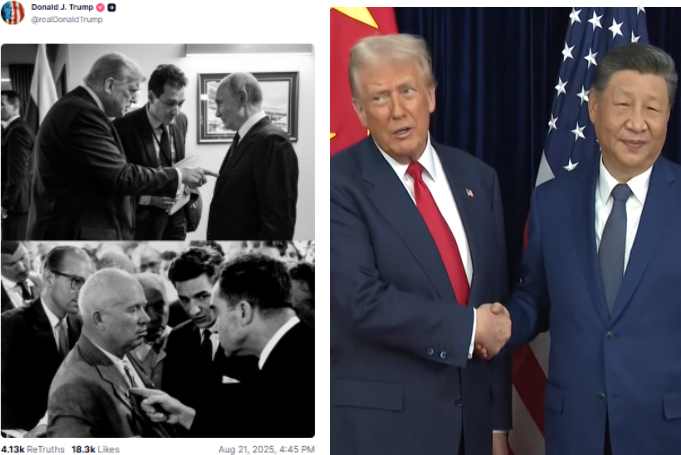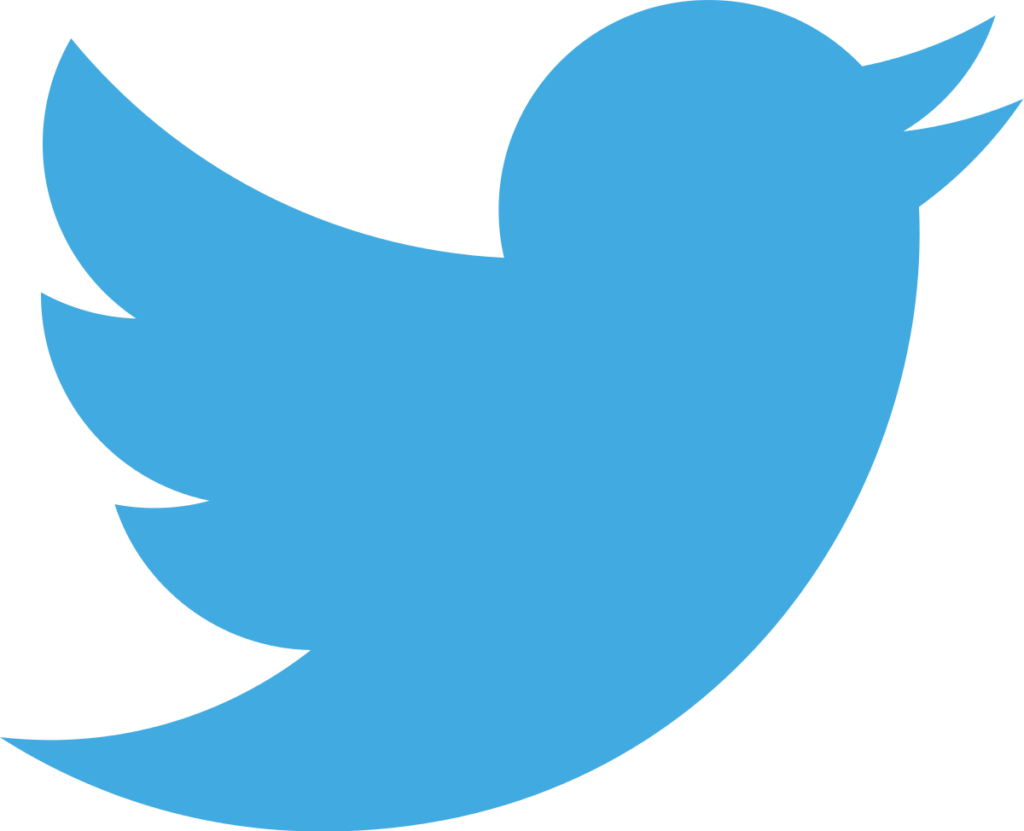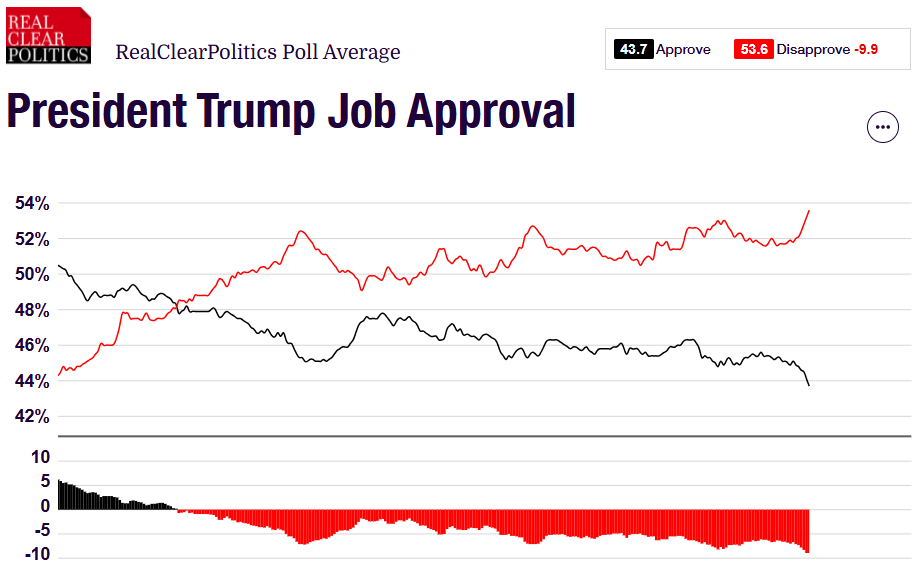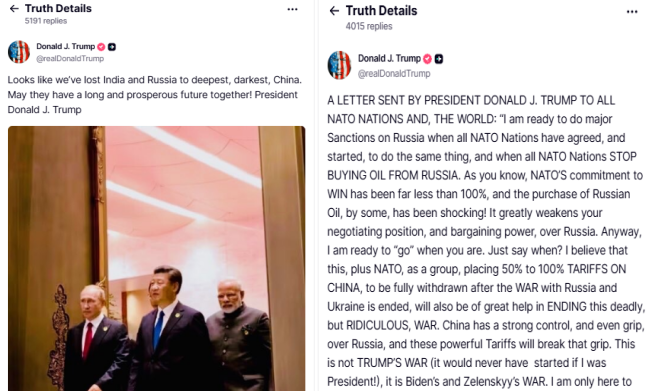 [1]
[1]
By John Helmer, Moscow
@bears_with [2]
Did Xi Jinping demonstrate escalation dominance over Donald Trump at their meeting in Busan on October 30 (lead image, right) in a way which Vladimir Putin failed to do with Trump at their meeting in Anchorage on August 15? Has the Zhongnanhai [3] strategy been more effective in deterring US escalation of trade war and of military measures against China than the Kremlin strategy has managed against the US and NATO?
Listen to the new podcast [4] with Nima Alkhorshid for the answers which aren’t publicly acknowledged but vigorously debated in private in Moscow, Beijing, and Washington.
Start by ignoring everything Trump says in his brief press gaggles and Oval Office pressers, and also in the stream of his daily tweets. Instead, read what the White House has said in print about what was agreed between Trump and his foreign government interlocutors. These are what are officially called “White House Fact Sheets”.
From August 16, when Trump met Putin, until November 1, two days after Trump met Xi, there have been 36 Fact Sheets [5]. They have been issued to document and itemize the terms of agreement Trump’s officials say they made with Japan on September 5 [6]; on September 19, after Trump had met [7] with UK Prime Minister Keir Starmer; on October 9, after Trump met [8] with Finland’s President Alexander Stubb; on October 20 when Australian Prime Minister Anthony Albanese signed an arms, minerals and trade agreement [9]; and then between October 26 and 29, when terms of agreement were negotiated [5] at Trump’s meetings with the heads of government of Malaysia, Japan, and South Korea.
Finally, here is what the White House said on November 1 are the terms which Trump and Xi agreed at their meeting in Busan forty-eight hours earlier: ten points are listed as the “Chinese actions”; five points are the “American actions”; and there are five points which the US claims [10] to have agreed but the Chinese have not confirmed.
However, there is no fact sheet identifying anything Trump and White House officials say they have agreed with Putin. Repeat — no terms of agreement between the US and Russia since the August 16 summit meeting; no points of agreement since they followed up with their telephone call on October 16.
One explanation for this is that Trump has not agreed to any of the terms Putin has discussed with him. A second explanation is that Trump has told Putin he has agreed, then changed his mind. A third explanation is that Trump is vacillating; he didn’t mean to change his mind but has been persuaded to do so by the European allies and some of Trump’s subordinates at State, Pentagon, and CIA. A fourth explanation is that Putin aims at preserving escalation dominance on the Ukrainian battlefield while allowing Trump to appear that he and the European allies aren’t losing the war. A fifth explanation is that Putin and Trump are agreeing to bide or buy time from each other, delaying public realization and the political cost of who has the weaker and the stronger hand.
The sixth explanation is that all five are correct while the evidence can be interpreted to mean each one, all, or none of them.
These are details which the US opinion polls are showing American voters aren’t following. But – and this is an existential threat for the White House – voter disapproval of Trump’s performance overall is growing sharply; even more sharply for his conduct of the Russia-Ukraine war talks [11].
 [12]
[12]At the level of 53.6%, Trump’s job disapproval rating [11] is higher, and the 9.9 percentage point gap with the approval rating larger than at any time in his term so far. The negative approval gap on the Ukraine war is almost 20pp.
After the mid-August meeting, Trump had tweeted [13]: “A great and very successful day in Alaska! The meeting with President Vladimir Putin of Russia went very well, as did a late night phone call with President Zelenskyy of Ukraine, and various European Leaders, including the highly respected Secretary General of NATO. It was determined by all that the best way to end the horrific war between Russia and Ukraine is to go directly to a Peace Agreement, which would end the war, and not a mere Ceasefire Agreement, which often times do not hold up. President Zelenskyy will be coming to D.C., the Oval Office, on Monday afternoon. If all works out, we will then schedule a meeting with President Putin.”
Trump was putting on the record that his objective was a multi-term “peace agreement”, not a “mere ceasefire agreement”.
Three days later, on August 19 [14], after meeting the Europeans and Zelensky, Trump’s terms of agreement were changing. He agreed now, he said, to “a meeting, at a location to be determined, between President Putin and President Zelenskyy. After that meeting takes place, we will have a Trilat, which would be the two Presidents, plus myself.” He didn’t say — and the White House didn’t announce in a “fact sheet” — what the terms of agreement would be for such a summit meeting, let alone whether they were the same as the terms Putin had spelled out for Trump at Anchorage.
On August 21 [15], Trump published matching photographs of himself poking a finger at Putin and President Richard Nixon poking his finger at Soviet President Nikita Khrushchev in June 1959 (lead image, left). Trump’s meaning was to demonstrate his dominance without revealing that the conversation with Putin was quite different. Sixty-six years earlier, Nixon had been using his finger to defend against Khrushchev’s verbal attack in their argument over kitchen technology [16]. In both photographs the US president had been poking his finger in vain.
On October 16 [17] Trump and Putin had a lengthy telephone call which Trump called “very productive”. He then announced “we agreed that there will be a meeting of our High Level Advisors, next week. The United States’ initial meetings will be led by Secretary of State Marco Rubio, together with various other people, to be designated. A meeting location is to be determined. President Putin and I will then meet in an agreed upon location, Budapest, Hungary, to see if we can bring this ‘inglorious’ War, between Russia and Ukraine, to an end.”
In fact, within five days the meetings between the foreign ministers and then with the presidents in Budapest had been cancelled [18]. Trump then imposed his new sanctions to cut off the oil trade between Russia, China and India on October 22 [19]. The headline was: “Treasury Sanctions Major Russian Oil Companies, Calls on Moscow to Immediately Agree to Ceasefire.”
Trump had already warned this was coming when he tweeted on September 5 – after Putin, Xi and India’s Prime Minister Narendra Modi met together at Tianjin, China. “Looks like we’ve lost India and Russia to deepest, darkest, China. May they have a long and prosperous future together!” Trump said [20].
A week later on September 13 [21], he said he thought Russia could be forced into ending the war if the US and NATO combined to stop Russia’s export of oil to China, India, and the NATO states. “China,” he tweeted, “has a strong control, and even grip, over Russia, and these powerful Tariffs will break that grip.”
 [22]
[22]Source: left,https://truthsocial.com/@realDonaldTrump/posts/115151159839778614 [20] right, https://truthsocial.com/@realDonaldTrump/posts/115196697263809382 [21]
Just five weeks had elapsed by the time Trump renounced whatever he and Putin had agreed in Alaska. He was now publicly calling Putin a paper tiger; he was convinced, he tweeted [23], that “after getting to know and fully understand the Ukraine/Russia Military and Economic situation and, after seeing the Economic trouble it is causing Russia, I think Ukraine, with the support of the European Union, is in a position to fight and WIN all of Ukraine back in its original form. With time, patience, and the financial support of Europe and, in particular, NATO, the original Borders from where this War started, is very much an option.”
Trump was preparing to escalate with a combination of new military threats and new economic sanctions. These followed with the Tomahawk missile proposal and other long-range missiles to strike inland Russian targets. Putin has responded with counter-military threats — the Burevestnik, the Poseidon, and then the Sarmat. “There are also no interception methods”, Putin added [24]. Twenty-four hours later, after meeting Xi in Busan, Trump said he was dropping his 7-day attempt to stop Russian oil flowing to China.
Reading the body language, the words, the clock, and then the public opinion polls reacting to all of this evidence allows three conclusions about who holds escalation dominance today:
An unusually uninhibited commentary this week from Kiev on the consequences at the Zelensky presidency and the Ukrainian General Staff from the accelerating collapse at the front indicates that Trump’s problem is the urgent one.
“The Russian leadership…is quite confident that the current tempos of military operations will be enough to break down Ukraine. Higher levels of military investment and action are seen as not worth the potential economic and social costs…Today I only covered Pokrovsk, but the same catastrophe is unfolding across the frontline, north, south, and centre. Let’s see if Zelensky ends up getting rid of Syrsky. The most likely replacement is certainly Drapaty, with a concurrent rise of Biletsky and Prokopenko. But then things will truly get interesting for Zelensky – if he thought Zaluzhny was worryingly political, wait until he gets the White Fuhrer close to power [25].”
 [26]
[26]Top -- Brigadier General Andrei Biletsky, commander of the Third Corps, founder of Azov, also known as the ‘White Fuhrer’. Bottom, left General Mikhail Drapaty; bottom right -- General Denis Prokopenko, commander of the 1st Azov National Guard Corps. Source: https://substackcdn.com/image/ [27]